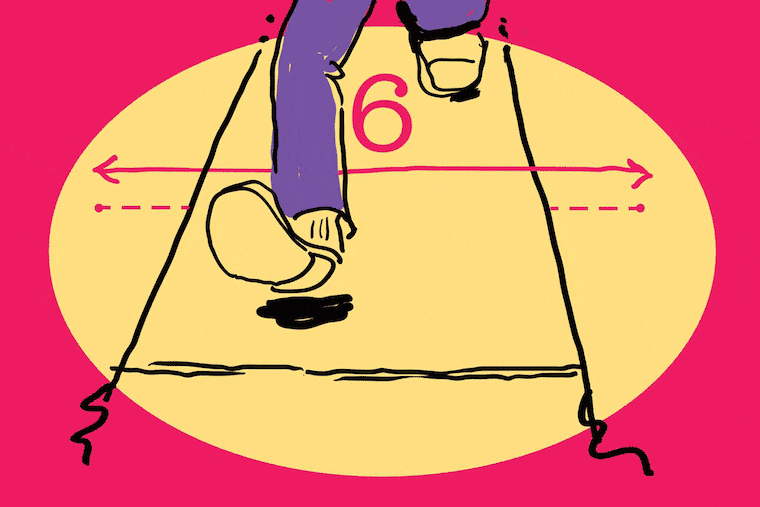This is what 6 feet apart looks like
Six feet apart is a new measure of our world. Since walking around with measuring tape would feel both annoying and absurd, we’ve put together some ideas to help you visualize safe social distancing.

By now, it’s drilled into our brains: Keeping a 6-foot distance from other people helps protect us from catching and spreading the coronavirus.
But what’s not so clear — what does 6 feet actually look like?
Since walking around with measuring tape would feel both annoying and absurd, we’ve put together some ideas to help you visualize safe social distancing.
Philly sidewalks
Less than 6 feet: The width of many Philly sidewalks
6 feet or wider: The sidewalks on “civic/ceremonial streets” like Broad and Market, and “high-volume pedestrian streets,” like the Center City section of Walnut and Sansom Streets
At a minimum, the U.S. Department of Transportation requires that sidewalks be 5 feet wide. In Philadelphia, 5 feet is the standard width requirement for most residential neighborhoods. But plenty are even narrower.
“Most of the homes and sidewalks in Philadelphia were built over 40 years ago, so there are many existing sidewalks that are approximately 4 feet wide,” says Philadelphia Streets Department’s Keisha McCarty-Skelton.
Width requirements aren’t much larger for the city’s commercial corridors, like sections of Germantown and Girard Avenues, where 6 feet is the minimum. Stand on the edge of one of these sidewalks, and it’s still impossible to keep a full 6 feet from a passerby.
To properly maintain social distancing, often you’ll need to step off the sidewalk when passing others. Of course, practice common sense, and look both ways before hopping into the street or even the grass. You never know when a car, cyclist, or runner might be zipping by, and in some instances, the risk will outweigh the benefits.
More expansive stretches of sidewalk do exist in the city. Streets like Broad and Market, categorized by the city as “civic/ceremonial streets,” require 10-foot or wider sidewalks. And “high-volume pedestrian streets,” like those surrounding Center City’s shopping district, require 8-foot or wider sidewalks. Just keep in mind, both locations might be more bustling on a sunny afternoon than your neighborhood side street.
Any 76er
Less than 6 feet: A small list of talented players
6 feet or taller: Joel Embiid and all of his Philadelphia 76ers teammates
If you’re a basketball fan, Joel Embiid might be the perfect person to visualize as you’re walking around outdoors. The Philadelphia 76ers All-Star is a full foot taller than 6 feet, giving you a little cushion, if you can precisely summon him into your mind. Any 76er might do: The shortest is Raul Neto, at 6′1″.
But not all basketball pros are giants. Isaiah Thomas may only be 5′9″, but he’s earned two All-Star Game appearances with the Boston Celtics. And not to mention 5-foot-3 Tyrone “Muggsy” Bogues, the shortest player in NBA history.
So choose your basketball players wisely. You can even get creative and bring cardboard cutouts. Both Embiid and Ben Simmons (6’10″) would be good company at your next picnic. Call on “Wilt the Stilt” Chamberlain (7’1”) to join you, too. Laid out from the edges of your blanket, their cutouts would create the ultimate barrier to keep people from walking too close.
Shopping carts
Less than 6 feet: One shopping cart
About 6 feet: Two shopping carts
The average grocery cart is about 3 feet long. Most supermarkets have tape on the ground by the checkout lines to create 6-feet markers. If someone’s creeping toward you past the marker, it’s OK to politely ask them to give you some space. A cart is not a barrier for the virus, nor is it long enough to meet social distancing guidelines.
But a shopping cart can provide a good way to think about social distancing when you imagine two attached together. As you navigate the store, picture an extra cart hooked to the front of yours. It’ll make you more aware of how close you’re getting to others.
Your arms
Less than 6 feet: The average man or woman’s arm span
6 feet: The average man or woman’s arm span plus a few inches
Perhaps the best way to visualize 6 feet is to use your own arms. According to Scientific American, when you extend your arms out to the sides, the distance between the middle fingertip of your left hand and that of your right hand is about the same as your height.
According to the U.S. Centers for Disease Control and Prevention, the average height of an adult American man is 5’9″; for an adult American woman, it’s 5’3″. So, if you’re of average height, that would mean your arm span would be about 1.5 inches shy on both sides if you’re a man, about the width of a cardboard paper towel tube. If you’re a woman, that gap is 4.5 inches on each side, about the height of a can of beans. Of course, make your own calculations based on your own height.
As stay-at-home orders lift, this may come in handy when you’re hanging out with friends but want to remain socially distanced. Each of you can extend an arm, with a few inches remaining between your fingertips. This will confirm that you’re standing or sitting 6 feet apart.
Cars
About 6 feet: The width of a car
More than 6 feet: The width of a parking space
The average width of a midsize vehicle is about 6 to 6-and-a-half feet long. Keep the image of a car in your mind, or if you want to be extra cautious, picture a parking space. (Since parking spaces have to fit cars, they’re obviously a bit wider than a car itself.) In the United States they average between 7 and 9 feet wide.